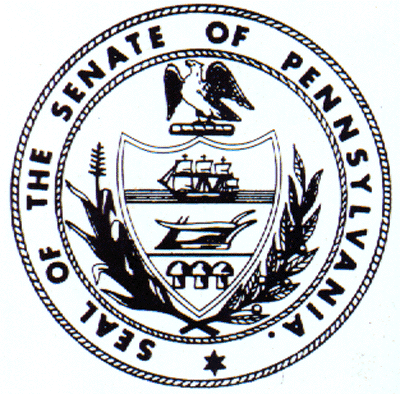|
|
||||||
SENATE DEMOCRATS UNVEIL PROPERTY TAX & EDUCATION FUNDING PLAN HARRISBURG, June 23, 2003 – Senate Democrats today announced a plan that combines a Republican tax shifting measure with the basic concepts of Governor Ed Rendell’s proposals to reduce local school property taxes and increase education funding. Democrats will introduce legislation that would fully fund the property tax relief portion of the plan announced by the governor in March, allowing each school district in the commonwealth to lower property taxes (except Philadelphia, which would lower its wage tax.) A district would do so by using the proceeds of an increase in the state personal income tax and other sources. In the first year, the PIT would rise by .4 percent, to 3.2 percent. Eventually, additional revenue from slot machines at racetracks would replace some of the PIT increase, permitting the rate to fall to 2.95 percent. It is currently 2.8 percent. Senate Democrats are prepared to offer their proposal as an amendment to other tax and education funding proposals that come to the floor. The amendment would retain provisions of the current Senate Republican proposal (SB 100) to give most school districts the choice of additional property tax reductions in exchange for a higher local earned income tax. Unlike the Republican proposal, however, which would require an average maximum hike of 1.6 percent in the earned income tax statewide, this approach would give homeowners property tax relief much more cheaply, because of the use of other revenue sources. In fact, in 49 of the 50 Senate districts, taxpayers would contribute less in additional PIT than they would receive in property tax relief. "This proposal accomplishes the governor’s objective of reducing property taxes by increasing the state share of education funding. It also preserves the Senate Republicans’ desire to give local taxpayers the option of trading part of their property tax burden for a higher local earned income tax," said Sen. Vincent J. Fumo (D-Philadelphia), the chairman of the Democratic Appropriations Committee and the prime author of the amendment. It also contains the same 2.8 percent statewide subsidy increase proposed in the Republican-sponsored HB 113. "When implemented, this plan will nearly return the commonwealth’s share of overall statewide basic education spending to its historical level of 50 percent," said Democratic Leader Sen. Robert Mellow (D-Lackawanna.) Under the Democrats’ plan, every school board in the state would have to decide by August 5 whether or not to accept state tax relief – that is, to reduce its district’s property tax, dollar-for-dollar, by the amount it receives from the Rendell proposal. In the first year, the money for those reductions would come from a .4 percent increase in the state personal income tax, from the current 2.8 percent to 3.2 percent, plus money from increases in the malt beverage tax and the cell phone tax. As in the original Rendell plan, school districts would be able to reduce property taxes anywhere from 15 to 60 percent. They would achieve the property tax cuts through the homestead exemption, giving each residential homeowner in the district an equal dollar-amount reduction. The Democrats’ amendment allows school districts to achieve even further property taxes reductions, however, through the mechanisms of current SB 100. If it accepts the state relief, a district would be required to offer a referendum on its November ballot, asking voters if they want to trade off more of their property tax for a higher local earned income tax. (Several different scenarios can apply to various districts after they accept state tax relief. For those scenarios, and for an explanation of how the homestead exemption is defined in the state constitution, see the attachments at the bottom of this news release.) "Our plan preserves the flexibility for local taxpayers that Senate Bill 100 offers, but merely swapping one local funding source to replace another is not a real solution unless the commonwealth first restores an equitable state share for school district funding," said Mellow." "Simply lowering the property tax of poor people by raising the wage tax of poor people gives no help to poor school districts or their taxpayers," said Fumo "We have to give them state money to cut their real estate taxes." Although the state tax relief would be available to all districts, the property tax/earned income tax swap of SB 100 would not be available to Philadelphia and the other 11 empowerment districts, nor to Pittsburgh. "Our plan provides real tax relief to the poorest, struggling districts in the commonwealth, in contrast to SB 100 which exempts school districts in Philadelphia and Pittsburgh and several other currently distressed districts throughout the commonwealth," said Fumo. As in HB 113, the Senate Democrats’ plan would increase the basic state education subsidy by 2.8 percent above the current fiscal year, distributing the additional dollars through a formula -- based on aid ratio, poverty, and other factors -- that provides relatively more money to less wealthy school districts. It would also provide money for a 4.5 percent increase in special education funding. The .4 percent increase in the state income tax would be in effect for the 2003-04 fiscal year, fixing the new state PIT rate at 3.2 percent. It would decline to 3.025 the following year and to 2.95 in 2005-06. The lost PIT revenue would be made up by the proceeds from wagering on slot machines at racetracks. The plan does not include funding for other education initiatives that the governor has proposed, such as full-day kindergarten and reduced class size, although those could still be enacted through separate legislation and paid for through additional revenue increases. "Last week during the Appropriations Committee meeting in which SB 100 and HB 113 were reported to the floor, Republican leaders indicated they were willing to consider ideas for improving their plan, noting that no one has all the answers to solve the current challenge of providing an equitable funding system for local school districts, while relieving tax payers from their current burden," said Mellow. "This plan answers that challenge by building upon the basic components of Governor Rendell’s tax relief plan, but also integrating his plan within the education funding proposals now put forward by our Republican colleagues." # The Homestead Exemption Under a homestead exemption, property tax payers are permitted to deduct a set amount from the value of their home before calculating the tax owed. The State Constitution sets a maximum amount for a Homestead Exemption, equal to 50 percent of the value of the median assessed home. Thus, the person with the median assessment would get a 50 percent tax break if the maximum Homestead Exemption is offered. When the state tax relief plan, as proposed in March by the governor, is implemented, all districts would be able to lower their property taxes by giving their property owners a homestead exemption for their primary residence. The total dollar reduction would be equal to the additional state dollars coming into the district, and it would range from 15 to 60 percent of the total property taxes now being paid within a district. Each district would then divide the total amount of the reduction by the number of homeowners to determine the amount of the homestead exemption. Each homeowner within a district would receive exactly the same homestead exemption. For example: Let’s say in a hypothetical school district the median assessed value of all residential property is $160,000. The maximum value a homestead exemption would be $80,000. If the district used its maximum homestead exemption, that amount would be subtracted from the assessed value before the tax is calculated. If the district had a millage rate of 10, the dollar value of tax savings would be $800 for each home owner within the district. School District Scenarios Under SB 100 Provisions Once a school district accepts state tax relief, it will already have achieved a certain level of property tax reduction. That will set up several different possibilities for additional property tax cuts as envisioned in the current version of SB 100. In every case, a district could put a question on the November 2003 ballot. If the state tax relief was insufficient to allow a district to use 50 percent of its maximum homestead exemption, the district would have to offer voters the choice of increasing their local earned income tax by enough to give all residential property taxpayers at least a 50 percent homestead exemption. It could offer a greater reduction if it chooses. If a district reaches 100 percent of the maximum allowable homestead exemption through state relief, it can still choose to offer further property tax relief through millage reductions. It could put a question on the November ballot, asking voters if they want to lower property tax millage rates in exchange for a higher earned income tax. They would be permitted to replace up to 75 percent of the current total dollar value of property tax revenue. Facts About The Senate Democratic Plan The legislation would fully fund Governor Rendell’s proposed property tax relief plan announced in March, providing reductions ranging from 15 to 60 percent in total residential property taxes throughout all school districts in the commonwealth, except Philadelphia where residents would receive a .6% reduction in their wage tax. The plan would be funded through a .4% increase in the Personal Income Tax, raising the rate to 3.2% in the first year, through increased telecommunications and malt beverage taxes as proposed by the Governor in March, and through revenue from gambling. In future years the PIT increase would be reduced as the gaming revenue increased. The PIT rate would fall to 3.025% in the 2004-05 fiscal year, and 2.95% in the 2005-06 fiscal year. As provided in SB 100, School Districts would have to offer a referendum to their taxpayers, asking whether they wish to trade lower property taxes for higher earned income taxes. The plan would restore the state share to nearly 50%, after it has declined to nearly 35% in recent years. No Senate Republican legislative district would contribute more in increased PIT revenue than it would receive in state-funded property tax relief. A majority of households in every Republican Senate legislative district would also benefit. In contrast, the Senate Republican approach would require significantly higher wage tax increases to provide real property tax relief. If districts sought the maximum relief allowed under the Republican plan, this $2.7 billion tax shift would require an average wage tax increase of 1.6 percent, an increase more than 4 times higher than the .4 percent PIT increase in our plan. Many school districts in the Republican plan would have to impose substantially higher wage tax rates, beyond the crushing rates now imposed in the City of Philadelphia. School Districts such as Wallenpaupack, Pocono Mountain, and East Stroudsburg would have to impose wage taxes above 5 percent to maximize their homestead exemption under the Republican approach. This would be more than a 12-fold increase above the .4 percent PIT increase we would support. 281 of our 501 school districts would have to adopt wage taxes of 2 percent or higher under the Republican approach. |


